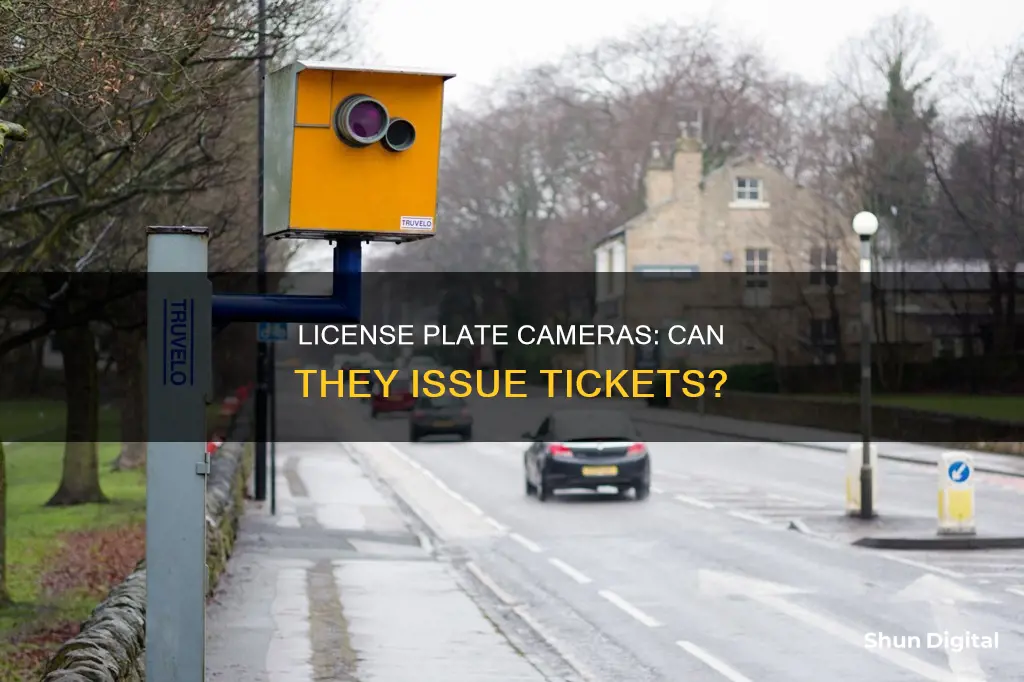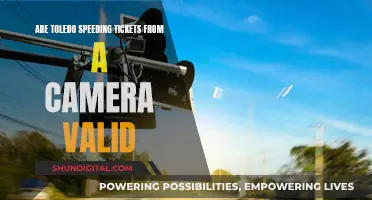
License Plate Recognition (LPR) technology is a powerful tool for law enforcement, with the ability to scan thousands of license plates, aiding in the apprehension of dangerous criminals. LPR systems use cameras to capture images of license plates, which are then processed to extract the license plate information. This data is then used for various functions, including traffic control, law enforcement, and granting access to restricted areas. While LPR technology does not issue tickets itself, it can be used in conjunction with automated red-light and speed enforcement systems to monitor and enforce traffic regulations. The data collected by LPR systems can also be used to track and identify vehicles and individuals for law enforcement purposes, raising concerns about privacy and data protection.
| Characteristics | Values |
|---|---|
| Purpose | Traffic monitoring, law enforcement, access control, parking enforcement, toll collection, revenue collection, and intelligence gathering |
| Technology | Optical character recognition, infrared lighting, image processing software |
| Users | Law enforcement agencies, parking management, highway agencies, private companies |
| Data Collected | License plate numbers, location, date, time, make and model of vehicle, photographs of vehicle and occupants |
| Data Storage | Stored indefinitely or for extended periods (up to 5 years) in databases maintained by police departments or private companies |
| Data Sharing | Data shared among law enforcement agencies and private companies, accessible to law enforcement without their own ALPR systems |
| Data Usage | Used for real-time and historical investigations, tracking vehicle movements, identifying travel patterns, locating stolen vehicles, and generating revenue through citations |
| Privacy Concerns | Potential invasion of privacy, targeting of sensitive places and communities, misuse by law enforcement, errors in identification |
What You'll Learn

License Plate Recognition (LPR) technology
At its core, LPR technology involves capturing images of license plates using cameras designed for this specific purpose. These cameras are equipped with integrated infrared LED illumination, enabling them to function effectively during both day and night. The cameras can be mounted on vehicles, traffic poles, or within controlled access points, such as gated communities or government facilities.
Once the image of a license plate is captured, the LPR system employs optical character recognition (OCR) to translate the image into machine-readable data. This process involves several steps, including localisation, segmentation, identification, and regional syntactical correction. The system needs to be taught to recognise different plate designs and variations, such as distinguishing between the letter "O" and the number "0".
The converted digital information from the license plate can then be used in various ways. For law enforcement, it serves as a valuable tool for scanning thousands of license plates, aiding in the apprehension of dangerous criminals, locating stolen vehicles, and identifying wanted individuals. The data can be cross-referenced with law enforcement databases, helping to track criminal suspects and place them at a specific location. Additionally, LPR technology can be utilised for traffic monitoring, toll collection, and parking management.
LPR systems offer significant advantages over traditional vehicle surveillance methods. The captured images can be stored and retained, providing a valuable historical record for investigations. Moreover, LPR technology does not require separate transponders or readers, as the necessary information is directly obtained from the license plate. This makes it particularly useful for applications such as speed control, red-light running, and accident scene reconstruction.
LPR technology has evolved significantly since its early days, with improved reliability and user-friendliness. It has become an integral component of municipal predictive policing strategies and intelligence gathering. However, it is important to note that the effectiveness of LPR systems depends on the specific country or region, as license plates vary in size, shape, and colour, and the software must be configured accordingly.
The Evolution of Bell & Howell's Electric Eye Camera
You may want to see also

ALPR data privacy concerns
Automatic License Plate Readers (ALPRs) are a growing concern for many citizens. While they can be used to aid law enforcement, they also raise serious civil rights and civil liberties concerns.
Privacy Intrusion
ALPRs can track individuals' movements without their consent, logging where they live, work, or visit. This constant monitoring of vehicle movements constitutes an invasion of privacy for many.
Data Security
There are concerns about how securely ALPR data is stored and who has access to it. The risk of data breaches could expose sensitive personal information to unauthorized parties, further violating privacy.
Surveillance Overreach
There are fears that ALPR technology could be used for purposes beyond those originally intended, such as tracking political activists or monitoring certain neighborhoods, leading to over-policing.
Lack of Regulation
The regulatory framework for using ALPR technology is often unclear or non-existent. This lack of oversight means there are no uniform standards for how data should be used or retained, which can vary significantly by jurisdiction.
Community Trust
The use of ALPRs can strain relationships within communities, especially in areas where residents feel they are being excessively watched or monitored. This can lead to a decrease in trust in local authorities and among neighbors.
Potential for Misuse by Law Enforcement
There is a significant concern about the potential misuse of ALPRs by law enforcement for personal or improper purposes. There is apprehension that these tools could be used to track individuals for reasons unrelated to criminal investigations, such as personal grievances or unlawful surveillance.
Data Privacy vs. Crime Prevention
The debate surrounding data privacy and crime prevention is still ongoing. While ALPRs can help achieve public safety goals, they also threaten privacy rights depending on how they are used and who uses them. Modern technology has enabled governments and private entities to acquire information on an unprecedented scale. While this data can be used to apprehend dangerous criminals, there are concerns about limiting access to authorized personnel who have met training, certification, and background check requirements.
Adjusting GoPro Hero 4 Camera for Wide Shots
You may want to see also

ALPR data retention and misuse
Automatic Number Plate Recognition (ANPR) and Automatic License Plate Recognition (ALPR) technologies have transformed the way we manage traffic, enforce laws, and enhance security. However, they have also raised complex legal and ethical concerns, particularly regarding data retention and misuse.
Data Retention Periods
Many countries have implemented data retention laws that specify time limits for storing ANPR/ALPR data. For example, a Colorado Statute passed in 2014 mandates the destruction of images obtained through passive surveillance by government entities within three years. These laws aim to protect individuals' privacy by preventing the indefinite storage of sensitive information.
Legal and Ethical Frameworks
The use of ANPR/ALPR technology must comply with local and national regulations governing data collection, retention, and access. Legal frameworks often define who has access to the data, typically granting access to law enforcement agencies, government bodies, and authorized personnel while restricting it for others.
Ethical Guidelines and Responsible Use
Transparency, data protection, and responsible use are crucial ethical considerations. Organizations and government agencies should be transparent about the deployment of ANPR/ALPR systems and their data collection practices. Robust data protection measures, including encryption, secure storage, and data anonymization, are essential to safeguard sensitive information from unauthorized access and misuse.
Balancing Surveillance and Privacy
The widespread deployment of ANPR/ALPR systems in public areas can create a pervasive surveillance network, raising concerns about individual privacy and personal freedom. These systems can track vehicle movements, revealing sensitive information about a person's habits, routines, and lifestyle. Therefore, balancing the benefits of this technology with privacy concerns is critical.
Misuse and Unauthorized Access
The vast repositories of license plate data collected by ANPR/ALPR systems are attractive targets for hackers, and unauthorized access or misuse of this data can lead to serious consequences and violations of privacy rights. Stringent access controls and data protection measures are necessary to safeguard against such misuse.
Unlocking Moto Z Play's Camera Modes: A Step-by-Step Guide
You may want to see also

ALPR's role in law enforcement
Automated License Plate Readers (ALPRs) are one of the most widely used law enforcement systems. They are camera systems that record license plates, as well as the time and location of the scan. ALPRs are often capable of capturing more than just license plates, including the surrounding scene, and even images of drivers and passengers.
ALPRs play a crucial role in law enforcement by aiding police officers in various ways. Firstly, they help in locating missing children or adults through Amber or Silver alerts. The system can promptly alert officers when a license plate associated with a missing person case is detected, enabling swift action. Additionally, ALPRs are instrumental in recovering stolen vehicles and license plates. By continuously scanning plates and comparing them to hotlists, officers are immediately notified of suspicious plates or vehicles, making it easier to track and recover stolen property.
Another advantage of ALPRs is their ability to help officers track down suspects and wanted individuals. The system can identify vehicles associated with outstanding warrants or criminal investigations, allowing law enforcement to locate and apprehend suspects more efficiently. ALPRs also assist in removing individual officer discretion from police stops, potentially leading to more equitable law enforcement outcomes. The technology can also be used to monitor and enforce traffic regulations, such as identifying vehicles with expired plates or violations related to incorrect vehicle registration.
Furthermore, ALPRs have been shown to increase the efficiency of police officers. With the ability to scan up to 3,600 vehicles per hour, ALPRs offer a significant improvement over traditional methods where officers manually check plates, which is limited to a maximum of 150 plates per hour. This increased efficiency translates into more effective policing, as demonstrated by a study conducted by the Cincinnati Police Department, where officers with access to ALPR technology made 15 times more arrests than those without.
While ALPRs offer numerous benefits, it is important to acknowledge potential drawbacks. Unregulated use of ALPRs can lead to errors, resulting in the wrong vehicle or person being stopped. It may also raise privacy concerns as it can capture sensitive information about individuals. Additionally, there are concerns about the potential for ALPRs to be used in ways that infringe on civil liberties and threaten Fourth Amendment rights by enabling location tracking over time. Therefore, it is essential to have proper oversight, regulations, and community involvement in the deployment and use of ALPR technology by law enforcement agencies.
The Pros and Cons of Deleting Raw Camera Files
You may want to see also

ALPR's use in traffic monitoring
Automated license plate recognition (ALPR) systems are high-speed, computer-controlled camera systems that are used for traffic monitoring and management. ALPRs are typically mounted on street poles, streetlights, highway overpasses, mobile trailers, or attached to police squad cars. They are used to monitor and manage traffic flow, control access to restricted areas, and enforce traffic rules such as speeding and red-light violations.
One of the primary uses of ALPRs in traffic monitoring is to capture license plate numbers, along with the location, date, and time. This data is then uploaded to a central server and can be used by law enforcement agencies to track and manage traffic flow, identify vehicles of interest, and enforce traffic rules. For example, if multiple stationary ALPR cameras are installed along a road, the data can reveal the direction and speed of a vehicle, helping law enforcement agencies to monitor and manage traffic flow.
ALPRs can also be used to control access to restricted areas, such as critical infrastructure facilities like airports, prisons, and utility sites. By cross-referencing license plate and vehicle data against watch lists, ALPRs can help to mitigate threats and unwanted intrusions.
In addition to traffic monitoring and access control, ALPRs can also be used for toll enforcement on roads and bridges. They can capture license plate information and deduct the necessary amount from registered users, eliminating the need for manual toll booths.
The data collected by ALPRs can also be used to create statistics, filter out vehicles of interest, and even create car-free zones in cities to improve inhabitability.
While ALPRs have been widely adopted by law enforcement agencies and have proven to be effective in traffic monitoring and management, there are also concerns about privacy and data safety. The data collected by ALPRs can reveal intimate details about a driver's life, and there are questions about who has access to this data and how it is being used.
Trail Camera Technology: How Are They Made?
You may want to see also
Frequently asked questions
License Plate Recognition (LPR) is a technology that scans license plates and identifies vehicles from a database. LPR cameras are typically mounted on street poles, streetlights, highway overpasses, mobile trailers, or attached to police squad cars.
LPR cameras automatically capture all license plate numbers that come into view, along with the location, date, and time. This data, including photographs of the vehicle and its driver and passengers, is then uploaded to a central server. The data is used by police to find out where a plate has been in the past, identify travel patterns, and track vehicles in real-time.
LPR cameras themselves do not issue tickets. However, the data collected by these cameras can be used for traffic enforcement, such as monitoring for speeding violations or red-light violations. The data can also be used to identify vehicles with expired license plates or those that are delinquent on city or state taxes and fines.







